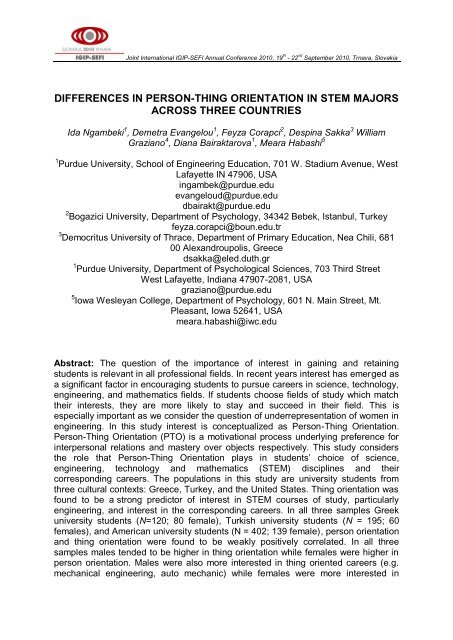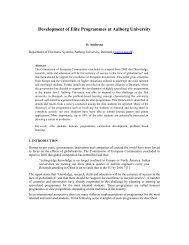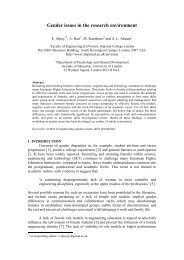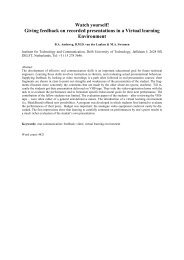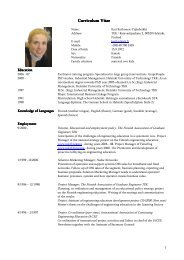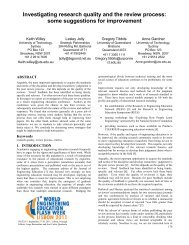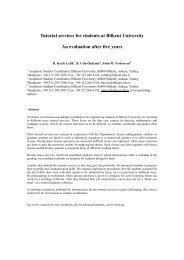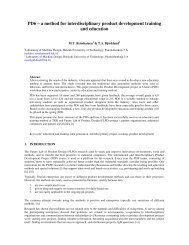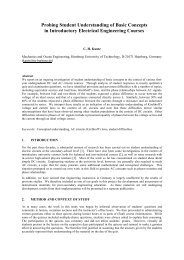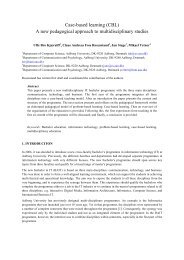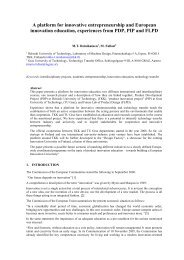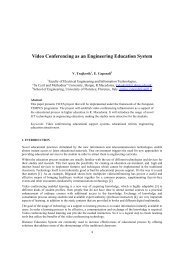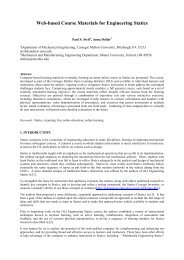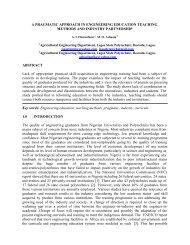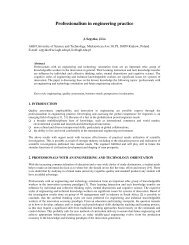1250 - SEFI
1250 - SEFI
1250 - SEFI
You also want an ePaper? Increase the reach of your titles
YUMPU automatically turns print PDFs into web optimized ePapers that Google loves.
Joint International IGIP-<strong>SEFI</strong> Annual Conference 2010, 19 th - 22 nd September 2010, Trnava, Slovakia<br />
DIFFERENCES IN PERSON-THING ORIENTATION IN STEM MAJORS<br />
ACROSS THREE COUNTRIES<br />
Ida Ngambeki 1 , Demetra Evangelou 1 , Feyza Corapci 2 , Despina Sakka 3 William<br />
Graziano 4 , Diana Bairaktarova 1 , Meara Habashi 5<br />
1 Purdue University, School of Engineering Education, 701 W. Stadium Avenue, West<br />
Lafayette IN 47906, USA<br />
ingambek@purdue.edu<br />
evangeloud@purdue.edu<br />
dbairakt@purdue.edu<br />
2 Bogazici University, Department of Psychology, 34342 Bebek, Istanbul, Turkey<br />
feyza.corapci@boun.edu.tr<br />
3 Democritus University of Thrace, Department of Primary Education, Nea Chili, 681<br />
00 Alexandroupolis, Greece<br />
dsakka@eled.duth.gr<br />
1 Purdue University, Department of Psychological Sciences, 703 Third Street<br />
West Lafayette, Indiana 47907-2081, USA<br />
graziano@purdue.edu<br />
5 Iowa Wesleyan College, Department of Psychology, 601 N. Main Street, Mt.<br />
Pleasant, Iowa 52641, USA<br />
meara.habashi@iwc.edu<br />
Abstract: The question of the importance of interest in gaining and retaining<br />
students is relevant in all professional fields. In recent years interest has emerged as<br />
a significant factor in encouraging students to pursue careers in science, technology,<br />
engineering, and mathematics fields. If students choose fields of study which match<br />
their interests, they are more likely to stay and succeed in their field. This is<br />
especially important as we consider the question of underrepresentation of women in<br />
engineering. In this study interest is conceptualized as Person-Thing Orientation.<br />
Person-Thing Orientation (PTO) is a motivational process underlying preference for<br />
interpersonal relations and mastery over objects respectively. This study considers<br />
the role that Person-Thing Orientation plays in students’ choice of science,<br />
engineering, technology and mathematics (STEM) disciplines and their<br />
corresponding careers. The populations in this study are university students from<br />
three cultural contexts: Greece, Turkey, and the United States. Thing orientation was<br />
found to be a strong predictor of interest in STEM courses of study, particularly<br />
engineering, and interest in the corresponding careers. In all three samples Greek<br />
university students (N=120; 80 female), Turkish university students (N = 195; 60<br />
females), and American university students (N = 402; 139 female), person orientation<br />
and thing orientation were found to be weakly positively correlated. In all three<br />
samples males tended to be higher in thing orientation while females were higher in<br />
person orientation. Males were also more interested in thing oriented careers (e.g.<br />
mechanical engineering, auto mechanic) while females were more interested in
Joint International IGIP-<strong>SEFI</strong> Annual Conference 2010, 19 th - 22 nd September 2010, Trnava, Slovakia<br />
person oriented careers (e.g. nurse, teacher). When only the STEM sample was<br />
considered, thing orientation was found to be highly correlated to an interest in thing<br />
careers but the same did not hold true for men in this sample. This would suggest<br />
that women need to be more interested than men do to pursue a career that is not<br />
gender role congruent.<br />
Key words: Person-Thing Orientation, STEM, Motivation, Career Choice<br />
1. Introduction<br />
The question of the importance of interest in gaining and retaining students is<br />
relevant in all professional fields. However, very little is known about the role and<br />
structure of interest in enrollment and persistence in science, technology,<br />
engineering, and math (STEM) fields, particularly engineering. In recent years<br />
interest has emerged as a significant factor in encouraging students to pursue<br />
careers in STEM fields [1]. Students who choose a field which is in line with their<br />
interests are more likely to remain and be successful in that field. On the other hand,<br />
students who choose fields outside of their interests often become bored and<br />
frustrated and more likely to leave [2]. The question of interest is an important one<br />
particularly in encouraging underrepresented groups to pursue engineering.<br />
The underrepresentation of women in science, technology, engineering, and<br />
mathematics (STEM) fields has emerged as a significant challenge. This<br />
underrepresentation is present across the globe [3]. Based on statistics published by<br />
the Jordanian Engineers Association in 2007, women made up 14% of the total<br />
number of engineers [4], in India female enrollment in engineering is 18% [5]. This<br />
underrepresentation is also present in all three cultural contexts considered in this<br />
study with the percentage of female engineering students in Turkey averaging 19%<br />
[6], in the United States the number is around 20% [7], while in Greece the average<br />
is about 25% [8].These low numbers have persisted despite a variety of efforts aimed<br />
at raising them. These efforts have largely focused on providing support to<br />
underrepresented groups and increasing the preparation of incoming students.<br />
However, literature on career choice suggests that vocational interest is a strong<br />
determinant of entry into and persistence in a career path [9]. Interests as related to<br />
vocational theory can be characterized in terms of a Person-Thing dimension and an<br />
Ideas -Data dimension [10]. In this study we focus on the Person – Thing dimension.<br />
Person-Thing Orientation (PTO) is conceptualized as a motivational process<br />
underlying preference for interpersonal relations and mastery over objects,<br />
respectively [11]. There is growing interest in exploring the acquisition of interest in<br />
Science, Technology, Engineering, and Math (STEM) careers based on PTO.<br />
There is evidence to indicate that that the structure of vocational interest is similar<br />
across cultures. In a study comparing American and Mexican engineering students<br />
and professional engineers found that the cross cultural structure of vocational<br />
interest remained the same [12]. This similarity was attributed to the professions<br />
studied, i.e. highly technical STEM professions, which remain fairly similar across<br />
cultures. A study of more culturally based professions, for example law, revealed<br />
differences in the structure of vocational interest [13]. Though vocational interest has<br />
a strong influence on career related choices, [9] as we consider interest and career
Joint International IGIP-<strong>SEFI</strong> Annual Conference 2010, 19 th - 22 nd September 2010, Trnava, Slovakia<br />
choice across cultural contexts, it is important to remember that culture has<br />
a significant effect on vocational choice and the role that interest plays in that choice.<br />
There are common assumptions about career choice, for example that all individuals<br />
have access to the same opportunities and that the choice of one’s career is an<br />
individual one based on an individual’s interest and ability, this is especially true in<br />
the United States; however, in many cultures this is not true. Therefore it is important<br />
to remember that “individuals' culture, their ethnic-racial background, language,<br />
socioeconomic status, sex, and religious affiliation all affect self-perception and view<br />
of career options“ [14].<br />
As a first step to examining the role of PTO as an influence on career choice, we<br />
must first understand the relationship between PO and TO and interest in the related<br />
careers particularly in STEM fields before the link can made to how these<br />
orientations influence the choice to pursue those careers. As such the purpose of this<br />
study was twofold: to examine differential orientation to persons and things among<br />
college students and the relationship of this Person-Thing Orientation (PTO) to major<br />
and career choice in three cultural contexts i.e. Greece, Turkey and the United<br />
States, and to examine the validity of the instrument used to measure PTO across<br />
cultural contexts.<br />
2. Method<br />
Data were collected from college students at three different universities in Greece,<br />
Turkey and the United States. Data from the Greek sample were collected at<br />
Democritus University of Thrace in North-Eastern Greece. The sample consisted of<br />
120 students, 60 STEM and 60 non-STEM. The STEM students were primarily from<br />
the civil engineering department while the non-STEM students were primarily from<br />
the department of education. The average age of the students was 23.4 years. The<br />
Turkish sample was collected at Bogazici University and consisted of 195 students;<br />
124 were from STEM-related departments and 71 were from social sciences (e.g.,<br />
psychology, sociology). The mean age of the students was 21 years. Bogazici<br />
University is a small competitive college in Istanbul, which accepts only applications<br />
from the top 1% from a nationally held entrance exam in which approximately 1<br />
million students compete. Data from the US sample were collected from 402 students<br />
at Purdue University in the Midwestern United States. The STEM students were<br />
primarily from the engineering program while the non-STEM students in this<br />
population were liberal arts students (e.g. history, sociology). Table 1 below shows<br />
the distribution of participants by major and sex in the three samples.<br />
Table 1: Sex distribution of participants<br />
STEM Non-STEM Total<br />
Male Female Male Female<br />
Greece 35 25 5 55 120<br />
Turkey 94 30 11 60 195<br />
United States 137 30 126 109 402
Joint International IGIP-<strong>SEFI</strong> Annual Conference 2010, 19 th - 22 nd September 2010, Trnava, Slovakia<br />
Data on orientation were collected using the Person-Thing Orientation Scale<br />
originally developed by Little [11] and revised and validated by Graziano, Habashi,<br />
Ngambeki, & Evangelou [15]. Data regarding career interest were collected using the<br />
Occupational Scale [16]. Demographic information was also obtained from all<br />
participants. For the US sample, data were collected using an electronic survey. For<br />
the Greek and Turkish samples data were collected using paper surveys. In the<br />
Greek and Turkish contexts all scales were translated into the language and back<br />
into English and expert feedback was sought on the validity of term equivalency.<br />
Scales were scored and data analyzed using common statistical methods.<br />
3. Results<br />
The results revealed that males were higher than females in thing orientation in all<br />
three contexts, while females scored higher than males in person orientation in all<br />
three contexts. Table 2 below shows the distribution of person and thing orientation<br />
by sex in the three samples.<br />
Table 2: Person and thing orientation means by sex (SD in brackets)<br />
Person Orientation Thing Orientation<br />
Male Female Male Female<br />
Greece 2.8(.57) 3.21(.65) 3.19(.81) 2.74(.73)<br />
Turkey 1.96(.68) 2.49(.58) 2.00(.73) 1.71(.78)<br />
United States 2.10(.69) 2.49(.61) 2.30(.78) 1.71(.79)<br />
Students in the Greek sample scored uniformly higher in both person and thing<br />
orientation than the other two samples. Contrary to the US sample, neither Greek nor<br />
Turkish female students differed from their male counterparts in TO. However, Greek<br />
and Turkish female students reported significantly higher PO than males.<br />
The results also revealed that STEM students were higher than non-STEM students<br />
in TO in all three contexts. Analyses also revealed a main effect of major in the<br />
Turkish context (F (1, 193) = 36.14, p
Joint International IGIP-<strong>SEFI</strong> Annual Conference 2010, 19 th - 22 nd September 2010, Trnava, Slovakia<br />
The results also revealed that PO and TO were independent in the Turkish sample (r<br />
= 0.08, ns) and positively correlated in the US (r = 0.2, p
Joint International IGIP-<strong>SEFI</strong> Annual Conference 2010, 19 th - 22 nd September 2010, Trnava, Slovakia<br />
Table 5: Person orientation, thing orientation, person and thing careers, correlations by major and<br />
gender<br />
STEM<br />
Non-STEM<br />
Female Male Female Male<br />
PO TO PO TO PO TO PO TO<br />
P<br />
0.147 -0.082 .298 .332 0.131 -0.009 -0.490 0<br />
career<br />
Greece<br />
T<br />
-0.062 .473** -.091 .007 .311* 0.253 0 -0.174<br />
career<br />
P<br />
.206 .240 .486** .160 .284* 0.056 0.496 0.469<br />
career<br />
Turkey<br />
T<br />
.293 .699** .222* .614** -0.025 .589** -0.158 .822**<br />
career<br />
P<br />
.150 -.080 .148 .034 .313** -0.008 .197* -0.035<br />
United career<br />
States T<br />
.404* .486* .021 .165 -.270** .446** -.248** 0.154<br />
career<br />
**Correlation is significant at the or below the 0.01 level (2-tailed); *correlation is significant at the 0.05 level (2-<br />
tailed)<br />
For female STEM majors PO is not related to an interest in person oriented careers,<br />
however thing orientation is related to an interest in thing oriented careers (Greece: r<br />
= .473, p < 0.001; Turkey: r = .699, p < 0.001; US: r = .486, p = 0.05).For male STEM<br />
students person orientation is only related to an interest in person careers for the<br />
Turkish sample (r = .486, p < 0.001), and thing orientation is only related to an<br />
interest in thing oriented careers in the same sample (r = .614, p < 0.001). In the non-<br />
STEM sample a clear predictive pattern does not emerge.<br />
4. Discussion<br />
The results indicate that thing orientation is an important predictor of interest in a<br />
given career. This finding agrees with previous studies which have concluded the<br />
structure of interest in closely related to and influences vocational choice [9]. The<br />
pattern of differentiation in PO and TO in all three contexts were similar, though not<br />
identical, by sex though it differs by major which also agrees with previous findings<br />
regarding the cross-cultural structure of interest. Women score higher in PO in all<br />
three contexts suggesting, as expected, that women in this sample are more<br />
interested in interpersonal relations than men. Whether this is an innate trait or the<br />
result of socialization remains open to discussion. Apart from the US context, women<br />
score about even with men in TO suggesting that, contrary to popular belief, women<br />
in these samples are as interested in things as men. Looking at PO and TO by major,<br />
it is clear that STEM students score significantly higher in TO than non-STEM<br />
students. This indicates that interest in or alternatively a disposition to mastery over<br />
objects is an important characteristic of students who select STEM majors. On the<br />
other hand, non-STEM students score significantly higher in PO indicating a greater<br />
interest in interpersonal relations. Interestingly while non-STEM students TO scores<br />
are well below the average, STEM students PO scores are about average suggesting
Joint International IGIP-<strong>SEFI</strong> Annual Conference 2010, 19 th - 22 nd September 2010, Trnava, Slovakia<br />
that while STEM students may be more interested in objects, this interest is not<br />
incompatible with a disposition towards people. The consistency of the pattern of TO<br />
and PO across the three cultural contexts suggests that these constructs themselves<br />
are independent of cultural factors.<br />
There is a significant finding that in all three contexts, TO was related to interest in<br />
thing oriented careers (such as mechanic and engineer) and PO was related to<br />
interest in person oriented careers (such as nurses and teachers). Given that most<br />
STEM careers are thing oriented careers; this finding indicates that TO may be<br />
leveraged to increase interest in STEM. This might also help to explain the<br />
underrepresentation of women in STEM fields. In all three contexts, women scored<br />
lower than men in TO and higher in PO. This would suggest that in order to increase<br />
women’s participation in STEM, efforts must focus on either finding ways to<br />
encourage the development of TO in women or must use PO as well as TO to relate<br />
to STEM careers. This could be done by manipulating the messages women receive<br />
about STEM careers to emphasize that while these careers are commonly perceived<br />
as thing oriented, many of them include person oriented goals and processes which<br />
female students might find more appealing.<br />
It is also interesting to note that when just the STEM sample is considered, for female<br />
students TO is strongly related to an interest in thing oriented careers while the same<br />
does not hold true for males. This could be because women’s interest must be<br />
stronger to induce them to participate in a career which is not gender role congruent.<br />
The pattern of correlations between P-TO and P-T careers is not consistent across<br />
the three samples suggesting that while PTO may be constant, the role PTO plays in<br />
vocational choice is probably mediated by other factors specific to the cultural<br />
climates.<br />
5. Conclusion<br />
The data revealed that Person-Thing Orientation is a significant predictor of major<br />
career choice in all three samples, though it suggests that this influence on career<br />
choice is mediated by other factors. This leads us to believe that person-thing<br />
orientation is an important dimension contributing to the interest in STEM majors and<br />
careers. An understanding of the nature and development of interest along these<br />
dimensions may be extremely beneficial as the engineering education community<br />
aims to address the underrepresentation of certain groups.<br />
Further research in this area could focus on examining the mediating factors affecting<br />
the link between PTO and career choice and the link between vocational interest in<br />
STEM careers and the actual choice to pursue these careers. An examination of the<br />
interaction between interest and other factors which may contribute to vocational<br />
choice, e.g. socio-economic status, ability, family background, etc should also be<br />
carried out.
Joint International IGIP-<strong>SEFI</strong> Annual Conference 2010, 19 th - 22 nd September 2010, Trnava, Slovakia<br />
References<br />
[1] Ceci, J., W.M. Willimas, and S.M. Barnett, Women's underrepresentation in science: Socio-cultural and biological<br />
considerations. Psychological Bulletin, 2009. 135: p. 218-261.<br />
[2] Seymour, E. and N.C. Hewitt, Talking about leaving: Why undergraduates leave the sciences. 1997, Boulder, CO:<br />
Westview Press.<br />
[3] Ramirez, F.O. and C.M. Wotipka, Slowly but surely? The global expansion of women’s participation in science and<br />
engineering fields of study, 1972-92. Sociology of Education, 2001.74(3): p. 231-251.<br />
[4] Gammoh, D., A. Mehrabian, and A. Ducharme. Education of women in engineering graduate schools in Jordan: An<br />
empirical perspective. in American Society for Engineering Education. 2008. Pittsburgh, PA.<br />
[5] Hersh, M., The changing position of women in engineering worldwide. IEEE Transactions of Engineering<br />
Management, 2000. 47(3): p. 345-359.<br />
[6] Zengin-Arslan, B., Women in engineering education in Turkey: Understanding the gendered distribution. International<br />
Journal of Engineering Education, 2002. 18(4): p. 400-408.<br />
[7] Gibbons, M.T., Engineering by the numbers, in Profiles of engineering and engineering technology colleges. 2008,<br />
American Society for Engineering Education: Washington, DC.<br />
[8] European Commission Directorate General for Research, She figures 2009: Statistics and indicators on gender<br />
equality in science. 2009, European Communities: Germany.<br />
[9] Humphreys, L.G. and G. Yao, Prediction of graduate major from cognitive and self-report test scores obtained during<br />
the high school years. Psychological Reports, 2002. 90: p. 3-30.<br />
[10] Prediger, D.J., Dimensions underlying Holland's hexagon: Missing link between interests and occupations? Journal of<br />
Vocational Behavior, 1982. 21(3): p. 259-287.<br />
[11] Little, B.R., Person-thing orientation: Manual for the T-P scale 3ed. 1974: Unpublished Manual.<br />
[12] Fouad, N.A., J.-I.C. Hansen, and F.A. Galicia, Cross-cultural similarity of vocational interests of professional<br />
engineers. Journal of Vocational Behavior, 1989. 34(1): p. 88-99.<br />
[13] Fouad, N.A., J.C. Hansen, and F.G. Arias, Multiple discriminant analyses of cross-cultural similarity of vocational<br />
interests of lawyers and engineers. Journal of Vocational Behavior, 1986. 28: p. 85-96.<br />
[14] Fouad, N.A., Cross-cultural vocational assessment. Career Development Quarterly, 1993. 42(1): p. 4.<br />
[15] Graziano, W., M. Habashi, and D. Evangelou, The Development of Interests: Persons and Things, in Twentieth<br />
Biennial Conference on Human Development. 2008: Indianapolis, IN.<br />
[16] Lippa, R., Sex differences in personality traits and gender-related occupational preferences across 53 nations:<br />
Testing evolutionary and social-environmental theories. . Archives of Sexual Behavior, 2010. 39(3): p. 619-636.


